In this issue:
2017 air fee – early estimate
To assist facilities in planning their expenditures, the
MPCA has estimated the 2017 air fee based on 2015 billable facility air
emissions. The early estimate of the 2017 air fee is $108 per ton of billable
emissions.
The air fee amount per ton of billable emissions is
determined by dividing the amount of money appropriated by the MN State
Legislature for the MPCA air program by the total billable emissions. The
increase in the 2017 air fee is primarily due to the decrease of billable facility
emissions between 2014 and 2015. There was a decrease of 20 percent for
billable emissions. The air program appropriation actually decreased 0.5
percent between the 2016 fee year (using 2014 emissions) and estimated 2017 fee
year (using 2015 emissions). Historic trends from 2006 (2004 emissions) to 2017
(2015 emissions) have shown a decrease of 62 percent for billable emissions and
an increase in air program appropriations of 37 percent.
The estimated 2017 air fee is draft and subject to change.
Invoices based on the 2015 air emissions will be mailed in the spring of 2017.
For more information see the MPCA Emission Inventory Fee webpage.
MPCA amending Exempt Source and Conditionally
Insignificant Activities Rules
The MPCA is amending its air quality rules for exempt
sources and conditionally insignificant activities and planning to publish
notice of request for comments in late fall 2016.
Conditionally insignificant activities (or CIA) are those
activities that in some cases can be treated as insignificant, for the purposes
of permitting, though have to meet the additional requirements in chapter 7008
of the Minnesota state rules.
During the recent Omnibus Air Rulemaking, the MPCA and
stakeholders identified issues with the chapter 7008 requirements for CIA that
were beyond the scope and timeframe to address in that rulemaking. The issues
are 1) the gap in federal enforceability of the CIA requirement for these
activities that emit only particulate matter and 2) the additional
administrative and potential cost burden of the record keeping and reporting
requirements for the CIA for very low emitting small sources. Sources that may
be affected by the proposed changes are:
- permitted sources relying on conditionally
insignificant activities to streamline their application and
- small facilities such as (but not limited to) auto
body finishing shops and woodworking manufacturers depending on the CIA to
avoid permitting requirements.
The rule changes are needed to address the federal
enforceability of the requirements for these activities.
If you are interested in receiving electronic
notices about these rules, the Agency encourages you to subscribe to Exempt
Source/Conditionally Insignificant Activities Rule email updates here. Information
on these rules is available on the MPCA’s Exempt
Source/Conditionally Insignificant Activities Rule webpage.
Update on Omnibus Air Rules
The MPCA is completing the last few steps of the
administrative process needed to publish the final Omnibus Air Rules, expected
in late November or early December 2016. The MPCA has made changes to the
proposed rule amendments based on comments received during the public comment
period and on the Administrative Law Judge Report. The MPCA will send an Air
Mail Bulletin when the Omnibus Air rules are finalized and will update the Omnibus
Air Rule Amendments webpage.
Pre-protocol modeling meetings
If you’re applying for a new permit or permit amendment, or
otherwise are planning to make a change at your facility, you may need to
submit an ambient air quality demonstration beforehand. If so, we would like to
talk to you before you prepare the required modeling protocol. When you need to
submit a modeling protocol or conduct an equivalent or better dispersion (EBD)
analysis, we encourage you to set up a pre-protocol meeting by contacting Steve
Pak (steven.pak@state.mn.us or 651-757-2633)
prior to submitting a protocol or completing any type of modeling or EBD
analysis. One key element of the meeting will be to define the scope of the
modeling. We believe this will help save time and effort for all.
Confidentiality reminders
If you are requesting that certain
parts of your permit application be treated as confidential, you must make sure
that your request meets the requirements of what MPCA is allowed to treat as
confidential, and submit all of the information as described in section 6 of Form
SCP-01.
The MPCA can
keep requested data confidential only if it meets applicable state and federal criteria.
State statutes provide confidentiality protection (or “non-public” status) for
certain kinds of information. Minn. Stat. Ch. 13 is the state law that
generally covers whether or not government data is publicly available. Minn.
Stat. § 13.37 and 116.075 describe “trade secret” data that qualifies for
confidential treatment. However, even if state law provides for confidential
treatment of certain data, the data will be public if it is emissions data as
defined in 40 CFR § 2.301. Both the federal Clean Air Act and Environmental
Protection Agency (EPA) regulations require that emissions data submitted to
the MPCA under Title V of the Clean Air Act
or Minnesota’s State Implementation Plan must be available to the
public.
If MPCA
agrees to keep certain information confidential, you must also continue to
treat it as confidential in future submittals. Whenever the confidential
information is referenced or used in any submittal to the MPCA, you must include
two copies of the submittal: one with all information visible (the confidential
copy) and one with the confidential information redacted (the public copy). Include
the reasons the information is confidential and a copy of MPCA’s letter
describing the agreement to hold the information confidential.
 Clean Diesel Grant open November 9 - December 22, 2016
The MPCA encourages owners of older heavy-duty diesel
engines to apply for Clean Diesel Grant funding to improve their fleets and
everyone’s air quality. A wide variety of
diesel engines are eligible, from heavy-duty vehicles to construction equipment
and even boats.
“Old, fully operating garbage trucks, bulldozers, or barges
may be eligible for funds to upgrade emission controls or replace or repower
them,” said Mark Sulzbach, MPCA’s Clean Diesel Grants manager. Previous projects
have cut air pollution from cranes and rock crushers to a paddleboat. This past
summer, MPCA grants helped replace eight heavy duty trucks. Most grants will
cover between 25 and 40 percent of the total project cost for vehicle replacement or an engine repower.
Visit MPCA's Clean
Diesel Grant Program webpage for application materials and to sign up for
the clean diesel opportunities email list.
|
When we think of breathing polluted air, we often focus on
how it affects our lungs, such as by making asthma or other lung conditions
worse. But air pollution can also have severe effects on our hearts and blood
vessels. A groundbreaking new
study helps us understand the causes behind exposure to air pollution and heart
disease. St. Paul was one of the cities included in the study. Find out how
exposure to air pollution affects your heart and arteries at BeAirAwareMN.org.
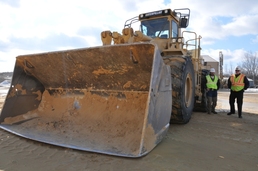 Erin Contracting, Mathiowetz
Construction, and Northdale Construction have all partnered with Project Green Fleet, a program run by the nonprofit
Environmental Initiative (EI) aiming to voluntarily reduce diesel pollution.
These three companies are now operating either upgraded or replaced diesel
machines, meaning each is more fuel efficient and emits less pollutants. Their
combined emission reduction efforts are equivalent to removing roughly 3,800
cars from the road each year in Minnesota.
Project
Green Fleet is one of several cost-effective strategies
to voluntarily reduce air pollution to protect public health. Clean Air Minnesota, a diverse
coalition of air quality leaders coordinated by EI, is working to scale up
Project Green Fleet and other efforts to
achieve their goal of voluntarily reducing air pollution emissions by 10
percent.
EI is expanding the reach of Project
Green Fleet with the goal of removing the emissions equivalent of an
additional 750,000 cars from the road by upgrading or
retrofitting at least 100 more heavy-duty diesel engines
statewide. To learn more, check out this video
or visit EI’s website.
|
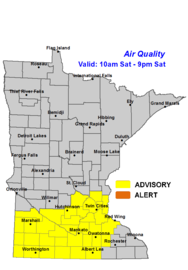
During the late winter and early spring, most long-range weather
forecasts were predicting a hotter summer across Minnesota. Hotter summer
temperatures bring concerns about bad air quality due to smoke events and
increased potential for ground-level ozone.
The warm temperatures
started early with an unusually warm late April and May. The pattern spread
across most of North America and as a result the Canadian wildfire season
ignited full-force across the Prairie Provinces. On Mother’s Day weekend,
Minnesota experienced its worst hourly air quality readings since MPCA’s
statewide monitoring network was installed in the 1990s. People across the
state reported thick, acrid smoke from the fires in Canada and parts of
northern Minnesota. Mother Nature helped put an end to many of the fires with a
warm but moist weather pattern across the affected Canadian provinces, but the
summer season was fast approaching.
|
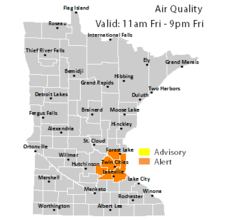
As predicted, 2016 was a hot summer and with
those temperatures came potential for high ozone days. Four days in June and six days in July
reached 90 degrees or warmer, with many more in the high 80s and even a few
days approaching 100 degrees. Meteorologists at the MPCA spent the summer
scouring meteorological and air quality monitoring data, watching for the right
combination of heat, sunlight, and light winds in the daily forecasts that
might create a potential air quality concern.
Four separate air quality advisories for ozone pollution
were issued in June and July when AQI values reached between 90-100, meaning
air quality had the potential to reach levels that could be unhealthy for some
people.
|
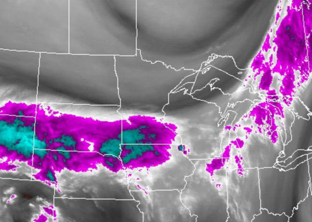 Forecasts showed three days had the potential to exceed an AQI of 100, considered
unhealthy for people sensitive to air pollution. These more concerning levels were averted
mainly due to showers and thunderstorms that cleared the pollution from the
air. Ozone formation requires just the right combination of warm temperatures,
sunny skies, and light winds, and those conditions became rarer heading into
August. A persistent pattern of hot but breezy days with occasional rain limited
ozone production throughout the latter half of the summer. Because of the rainy and windy pattern, even
with the hot temperatures, only one day this summer reached an AQI value of
100.
Despite the early indications of a bad ozone season,
preliminary monitoring results from 2016 indicate Minnesota is continuing to
comply with the National Ambient Air Quality Standard for ozone
|
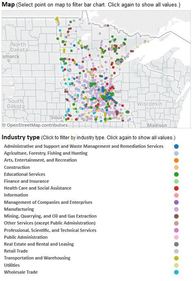
Emissions data from facilities with air permits are now
available on the MPCA website
in an interactive web tool. Dynamic maps, charts, and tables help users explore
emissions for criteria air pollutants, air toxics, and greenhouse gases
released by facilities across Minnesota.
You can use this tool to:
- Explore types and volumes of air pollutants emitted by permitted facilities
- See the highest-ranked emitters for specific pollutants
- Investigate changes in quantity of pollutants emitted over time
- Compare emission trends by industry type
|
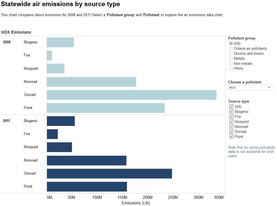
Statewide air
emissions inventory data for 2008 and 2011 are also available on the MPCA website in an interactive web tool. Users can explore
interactive charts and data tables to view and compare statewide emissions for
criteria air pollutants and air toxics. This
tool allows users to explore all sources of air pollution in Minnesota,
including point sources, which include large, permitted facilities; mobile
sources; fires; small, diffuse sources; and more.
This tool helps users:
-
Explore
Minnesota’s emission inventory by source types, categories, and source
classification codes (SCCs) for 2008 and 2011
-
View
percent changes by source types between 2008 and 2011
- Compare
emission trends by source types, categories, and SCCs over time
|
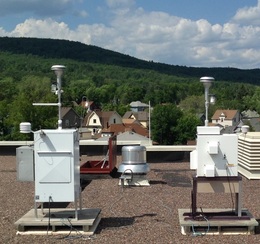
The Community Air Monitoring Project (CAMP) used funding
from the 2013 Minnesota Legislature to do short-term air quality monitoring in
selected Minnesota neighborhoods. The objective was to monitor and assess
air quality in low-income communities and communities of color that are
disproportionately impacted by air pollution emissions from highways, air
traffic, or industrial sources. The monitor was moved every three months,
with monitoring results posted to the CAMP
website after the data are quality reviewed and analyzed.
Overall, with a few exceptions, no large differences in air
pollutant concentrations were seen between the community monitored areas and
MPCA long-term monitors. Current long-term monitoring sites appear to provide a
reasonable estimate of overall air quality. MPCA continues to work with
communities that showed localized concerns with specific pollutants.
Since starting the project in October 2013, 10 community
sites have been monitored. Reports summarizing the results from the first
10 sites are on the website. The monitor is currently located in the St.
Anthony Park community in St. Paul. This monitoring site was selected to
meet Legislative objectives and in response to neighborhood input. Monitoring there will run from January 1, 2016
to December 31, 2016. Extending the
monitoring period to a full year will provide a longer view of the community’s
air quality, including seasonal variability.
For more information on the community air monitoring
project, visit the website or call the MPCA (651-296-6300 or 800-657-3864) and
ask for air data analysis staff. More information about Minnesota’s air
monitoring program is available on the MPCA’s air monitoring
website.
|
Federal Highway
Administration (FHWA) announces national alternative fuel and electric charging
network plan
FHWA announced 55 routes that will serve as a basis for a
national network of “alternative fuel corridors” across 35 states. As the refueling and charging stations are
built, owners of electric and alternative fuel vehicles will be able to drive
regionally and refuel along the way, just as conventional cars are able to stop
at gas stations at regular intervals along highway corridors. Alternative fuel and charging stations will
be labeled with highway signs, much like gas stations and rest stops are labeled
today. The plan designates I-94 through
Minnesota and Wisconsin as a future alternative fuel corridor, which will allow
Minnesota drivers to reach regional destinations, such as Fargo, Madison,
Milwaukee, and Chicago. For more
information and to see a map of the planned network, visit FHWA’s website.
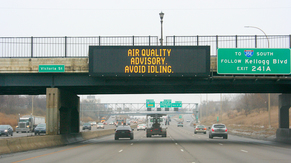
New study: U.S.
health burden from ozone and fine particles could be reduced
A study published in August by the American Thoracic Society (ATS) and the Marron Institute of Urban Management
at New York University shows health impacts from ozone and fine particle (PM2.5)
pollution could be reduced.
The ATS recommends ozone and PM2.5 standards that
are stricter than the National Ambient Air Quality Standards (NAAQS) adopted by
the EPA: 60 ppb for ozone and 11 µg/m3 for PM2.5, compared
with the current 70 ppb and 12 µg/m3 standards. The article
describes what health impacts could be avoided if ozone and PM2.5
concentrations across the country met the ATS’s recommendations.
Several California cities have the most to gain if their air
were cleaner. Nationwide, improving air quality to the levels recommended in
the report could avoid over 9,000 deaths, 21,000 cases of serious health
events, and 19 million “adversely impacted days” each year. A searchable database allows people to
view the results for their city or ZIP code.
Full article: Estimated
Excess Morbidity and Mortality Caused by Air Pollution above American Thoracic
Society–Recommended Standards, 2011–2013
|
New rules to reduce HFC
emissions
On September 26, 2016, the EPA finalized two rules intended
to limit the use of hydrofluorocarbons (HFCs) and to include them in refrigerant
recycling rules. HFCs are family of compounds that are used widely for many
purposes, but especially for refrigeration and air conditioning. They are also much stronger climate-changing
greenhouse gases than carbon dioxide. Substitutes for HFCs are widely available
and these rule changes will move the U.S. toward more widespread use of more
climate-friendly alternatives.
Under the new rules, the use of most HFCs in many commercial
space-cooling applications and in residential refrigerators, cold-storage warehouses,
and fire suppression systems will be prohibited, phasing in from 2020 to 2024
depending on the specific use. The prohibitions affect new equipment only;
older equipment may continue to operate using HFCs.
The recycling component of the final rules will reduce
emissions by, among other things, lowering the leak rates that trigger repair
requirements for large commercial and industrial air conditioning and
refrigeration units. These rules will
reduce emissions from both existing and new equipment.
International efforts are also underway to limit the use of
HFCs. On October 14, 2016, nearly 200 countries agreed to amend the Montreal
Protocol on ozone-depleting substances to include HFCs. Under the amendment,
HFC production and use in wealthy countries would be frozen and then gradually
reduced beginning in 2019, while production and use in less-wealthy countries
would be frozen in 2024. It is expected that as much as one degree Fahrenheit
of warming globally might be avoided as a result of this agreement. The
amendment to the Montreal Protocol is subject to ratification by the U.S.
Senate.
To learn more about EPA’s actions to reduce use of HFCs,
visit their website.
Boiler emission
standard to be revised
On July 29, 2016, The US Court of Appeals, DC Circuit
released its opinion in response to a challenge from industry and environmental
groups to various aspects of EPA’s maximum achievable control technology (MACT)
standard for boilers at major hazardous air pollutant (HAP) sources (40 CFR
Part 63 Subp DDDDD). The Clean Air
Act requires that MACT standard emission limits for new sources must represent
the emissions achieved by the best-performing sources in the category being
regulated. MACT standards for existing
sources must not be less stringent than the average emission limits achieved by
the best-performing 12 percent of the existing sources.
Petitioners challenged EPA, saying the agency disregarded
emissions data believed to represent best-performing sources when determining
emission limits for boilers. The court agreed, and as a result, vacated
the MACT standard for all major boiler subcategories that would have been
affected had EPA considered all sources included in the
subcategories. EPA reports that 11
emission limits for existing boilers and nine limits for new ones are affected
by the court ruling.
The vacatur will not go into effect until the court issues
the mandate for this opinion, so the existing rule remains in effect until then.
The court has received three petitions for rehearing and will not issue the
mandate until it addresses those petitions. One of the principal
petitions is EPA’s request that the court not vacate the rule, but rather
remand it back to EPA for further rulemaking. There is no set timeline for
when the court will take all these steps.
The EPA website for boiler performance standards has
changed. Find more information about
this standard, as well as other national emission standards for Hazardous Air Pollutants
and New Source Performance Standards for energy, engines, and combustion on the
EPA’s
website.
Air Mail is a quarterly,
email-based newsletter featuring updates on air quality issues and the work of
the MPCA and our partners. Subscribers to this list also receive Air Mail
Bulletins, which provide time-sensitive regulatory and technical updates.
To see past issues, Air Mail
Bulletins, or to subscribe, visit the MPCA's website.
If you have questions
or comments about Air Mail, please feel free to contact Amanda Jarrett Smith at
amanda.smith@state.mn.us.
|










